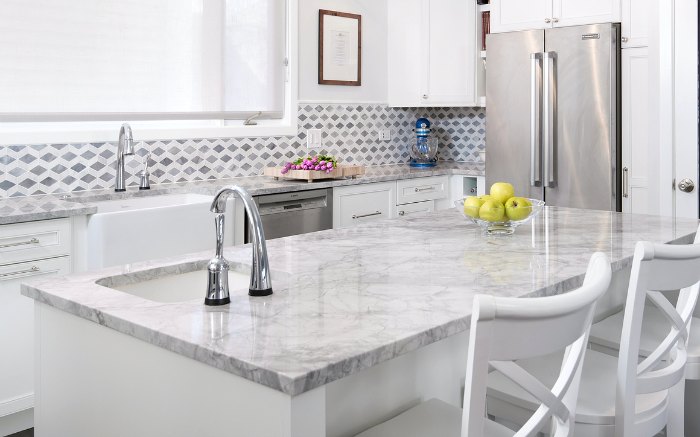Natural Stones
City Tile & Cabinets is your one-stop source for all your projectsGranite Countertop Anaheim, CA
Whoever coined the phrase “hard as a rock” might very well have been thinking of granite. Formed over millions of years from the compressed molten rock under the Earth’s surface, granite is extremely hard and durable.
With its heat-resistant qualities, granite doesn’t blister; it’s also unlikely to scratch or chip. When used for kitchen countertops, it’s far superior to marble, synthetic, and laminate. It’s also better-looking and has a luminous, dimensional quality when polished.
Granite is made up of interlocking mineral crystals, the most common being feldspar and quartz. But an array of other minerals can be included, and these make each piece of granite unique. Feldspar is the white mineral you see in granite; the light gray veins are quartz, and the black is typically mica.
Granite is drilled, chiseled, and blasted out of quarries in large blocks, and special milling machines then cut it into workable slabs. Typically, a slab of granite is around 4 to 5 feet (1.2 to 1.5 meters) wide and between 7 to 9 feet (2.1 to 2.7 meters) long. Other machines polish the material into a uniform thickness, usually about three-quarters of an inch to 1 1/4 inches (2 to 3 centimeters).
Turning raw granite into countertops requires special tools. Granite can be custom-made and professionally installed, but it’s also available in precut and edged countertops. The kitchen’s design, the shapes and sizes of the available precut material and the location of the seams will help determine if you can use precut and edged granite or if you need a custom installation.
Are you convinced that granite is the best choice for your kitchen or bathroom remodeling project? Contact us for a free quote or a free at-home consultation.

Quartzite Countertop
The interlocking crystalline structure of quartzite makes it a hard, tough, durable rock. It is so tough that it breaks through the quartz grains rather than breaking along the boundaries between them. This is a characteristic that separates true quartzite from sandstone.
Physical Properties of Quartzite
Quartzite is usually white to gray in color. Some rock units that are stained by iron can be pink, red, or purple. Other impurities can cause quartzite to be yellow, orange, brown, green, or blue.
The quartz content of quartzite gives it a hardness of about seven on the Mohs Hardness Scale. Its extreme toughness made it a favorite rock for use as an impact tool by early people. Its conchoidal fracture allowed it to be shaped into large cutting tools such as ax heads and scrapers. Its coarse texture made it less suitable for producing tools with fine edges such as knife blades and projectile points.
Where Does Quartzite Form?
Most quartzite forms during mountain-building events at convergent plate boundaries. There, sandstone is metamorphosed into quartzite while deeply buried. Compressional forces at the plate boundary fold and fault the rocks and thicken the crust into a mountain range. Quartzite is an important rock type in folded mountain ranges throughout the world.
.

